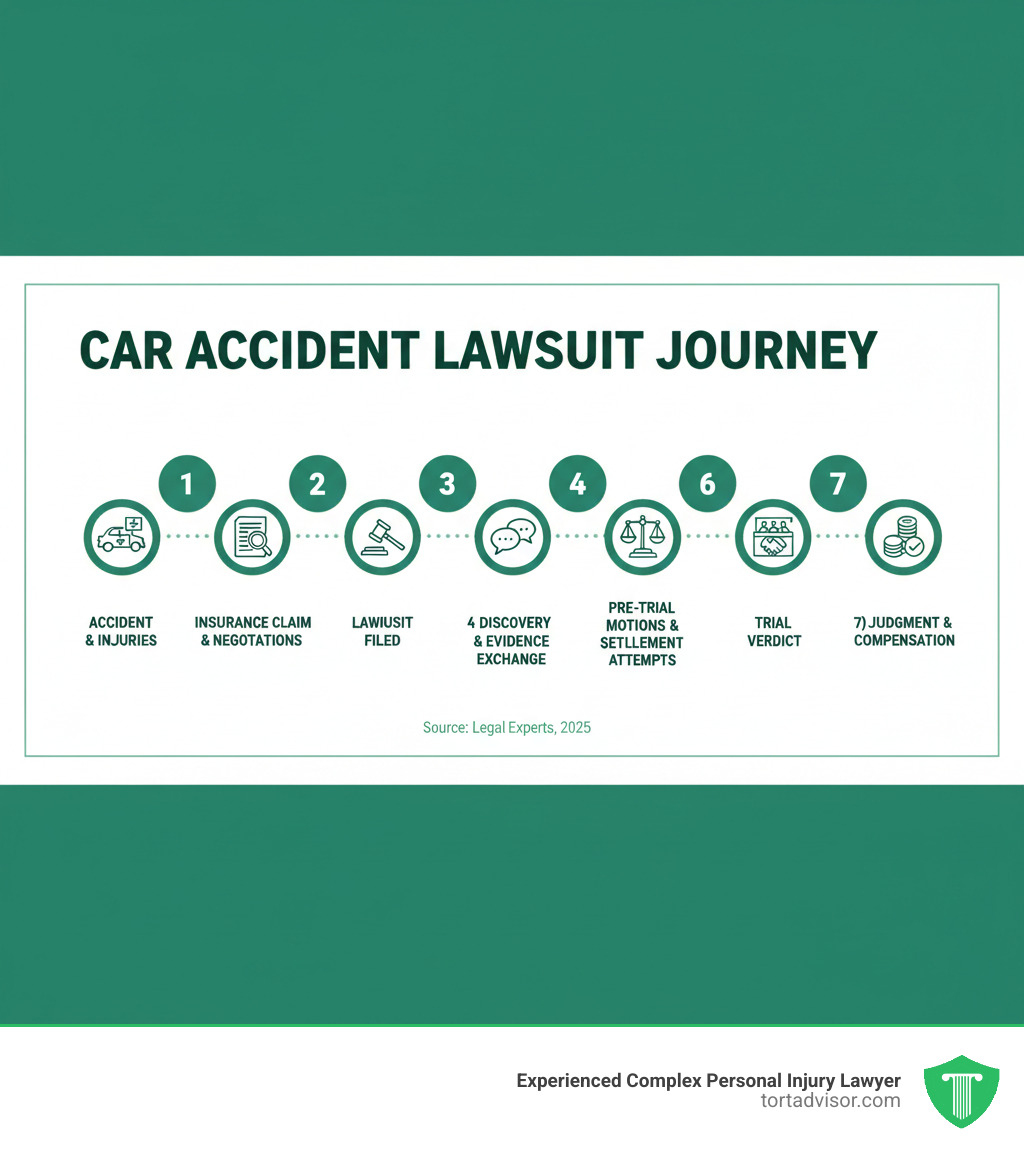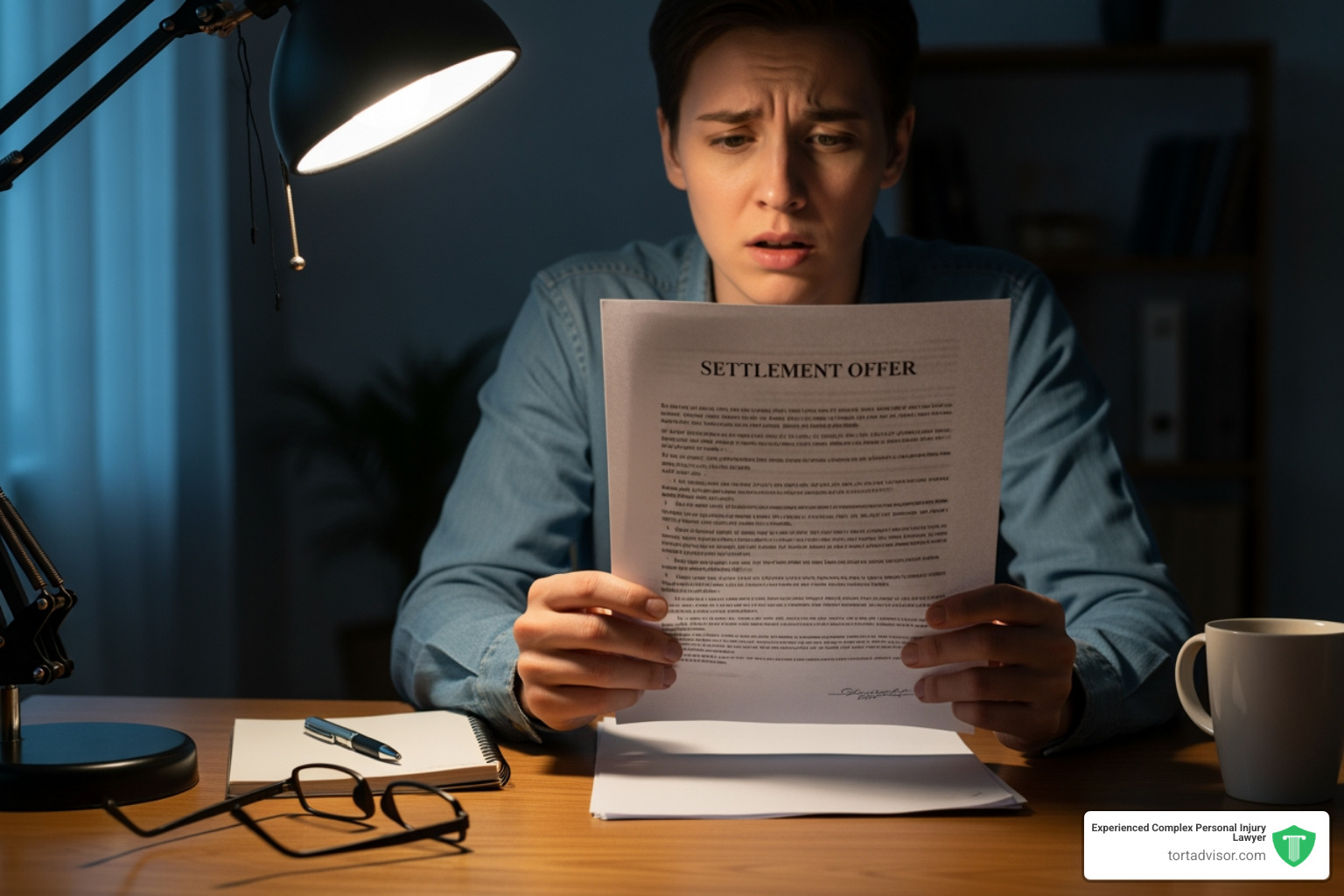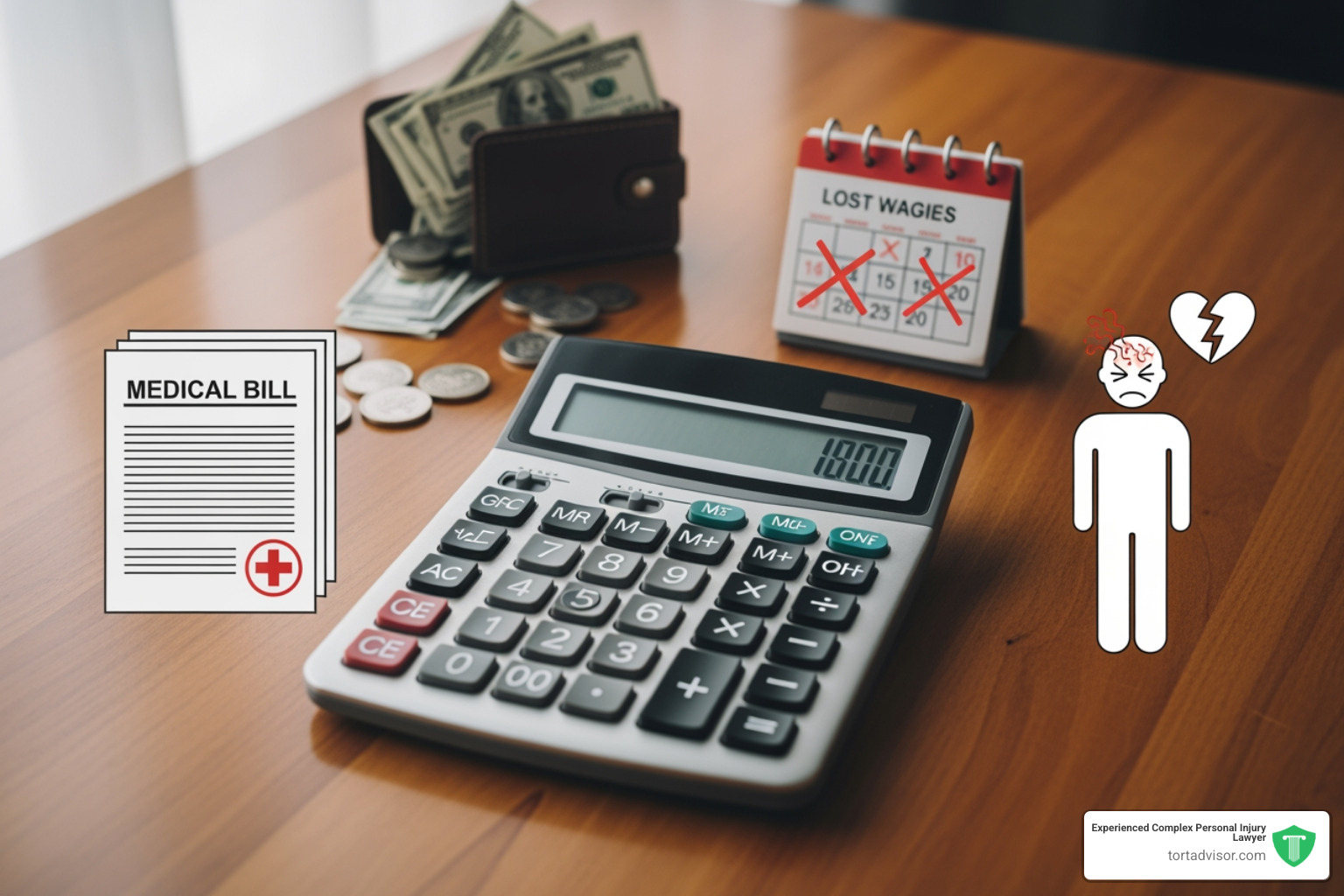


Understanding Your Path Through Car Accident Lawsuits
Car accident lawsuits are formal legal actions filed in civil court when insurance claims fail to provide fair compensation for injuries and damages. While most cases begin with an informal insurance claim, a lawsuit becomes necessary when negotiations stall or an insurer acts in bad faith.
Key Aspects of Car Accident Lawsuits:
- Purpose: To recover full compensation for medical bills, lost wages, property damage, and pain and suffering.
- When to File: When an insurance company denies your claim, offers an inadequate settlement, or disputes liability.
- Process: Involves filing a formal complaint, gathering evidence (findy), and potentially going to trial.
- Legal Basis: Most lawsuits are built on proving the other driver’s negligence caused your injuries.
- Compensation: Includes economic damages (medical bills) and non-economic damages (pain and suffering).
Insurance companies often try to minimize payouts, leaving victims struggling. An insurance claim is an informal negotiation with an adjuster, while a lawsuit is a formal court proceeding. Knowing when to escalate from a claim to a lawsuit is crucial for protecting your rights.
I’m Mason Arnao, and my work with personal injury law firms has given me unique insight into how car accident lawsuits progress. This experience has shown me how critical it is for injury victims to understand the legal process and connect with experienced attorneys who can fight for their rights.
Related content about car accident lawsuits:
Insurance Claim vs. Lawsuit: Knowing When to Escalate
After a car accident, the right first step is to file an insurance claim. This begins an informal negotiation process with an insurance adjuster. Most cases are resolved this way. However, when the insurance company isn’t playing fair, you must know when to escalate to a car accident lawsuit.
A lawsuit is a formal legal proceeding in court. It becomes necessary when the informal negotiation with the insurer breaks down. Filing a lawsuit is often the only way to get the compensation you deserve for serious injuries.
The Insurance Claim Route
When you file a claim, you present evidence like medical records and proof of lost wages to an adjuster. The adjuster’s goal is to protect their company’s bottom line by minimizing your payout. They may offer a quick, low settlement before you know the full extent of your injuries or try to blame you for the accident.
An experienced personal injury lawyer is your greatest asset here. They know how to build a strong claim, negotiate assertively, and prevent you from settling for less than your case is worth.
Deciding to File a Lawsuit
Certain situations clearly signal that it’s time to file a car accident lawsuit:
- Unsatisfactory Settlement Offers: If the offer doesn’t cover your medical bills, lost income, and pain and suffering, it’s time to take legal action.
- Claim Denials: If the insurer denies a valid claim, a lawsuit may be your only recourse.
- Disputed Fault: When liability is unclear, the formal findy process of a lawsuit is needed to establish the facts.
- Catastrophic Injuries: For severe injuries like spinal cord damage or a TBI, the necessary compensation will likely exceed what an insurer will voluntarily offer. A lawsuit is almost always required to recover the substantial funds needed for future medical care and lost quality of life.
A skilled attorney can evaluate your case, explain the pros and cons of a lawsuit, and help you decide on the best path forward. Often, the act of filing a lawsuit is enough to bring the insurance company back to the table with a more reasonable offer.
The Anatomy of Car Accident Lawsuits
If you decide to file a car accident lawsuit, it’s helpful to understand the roadmap of the legal process. A lawsuit unfolds in several distinct stages, though most cases settle before reaching the final stage.
Stage 1: Filing the Lawsuit
Your lawyer initiates the lawsuit by filing a complaint in court. This legal document outlines what happened, why the defendant (the at-fault party) is responsible, and the damages you’ve suffered. The court then issues a summons, which is formally served to the defendant, notifying them of the suit. The defendant must then file an answer responding to your allegations. Sometimes they may also file a counterclaim, alleging you were at fault.
Stage 2: The Findy Process
This is the evidence-gathering phase and is often the longest part of a lawsuit. Both sides exchange information to understand the case’s strengths and weaknesses. Key tools include:
- Interrogatories: Written questions that must be answered under oath.
- Requests for Production: Formal requests for documents like police reports, medical records, and photos.
- Depositions: Out-of-court testimony from parties and witnesses taken under oath.
- Independent Medical Examinations (IMEs): A medical evaluation by a doctor chosen by the defense.
Stage 3: Pre-Trial Motions and Final Negotiations
As findy concludes, both sides have a clearer view of the case, often leading to renewed settlement talks. Lawyers may file pre-trial motions, such as a motion for summary judgment, asking the judge to rule on the case without a trial. Many courts require mediation (a facilitated negotiation) or arbitration (a decision by a neutral third party) to encourage a settlement. Even as the trial date nears, final settlement attempts continue.
Stage 4: The Trial
If no settlement is reached, the case goes to trial. The process includes:
- Jury Selection: Choosing impartial jurors.
- Opening Statements: Lawyers for each side present an overview of their case.
- Presenting Evidence: Witnesses testify and are cross-examined, and documents are presented.
- Closing Arguments: Lawyers summarize their case and argue for a favorable outcome.
- Verdict: The jury deliberates and returns a decision on liability and damages.
An experienced attorney will guide you through each step, ensuring your story is told effectively.
Legal Foundations: Proving Your Case
Winning a car accident lawsuit requires building a legal argument that proves the other driver was negligent and that their negligence caused your harm. This involves understanding key legal principles and state-specific laws, particularly the tort of negligence.
The Core Principle of Negligence
To prove negligence, your attorney must establish four essential elements:
- Duty of Care: The other driver had a legal obligation to operate their vehicle safely.
- Breach of Duty: The driver failed to meet that obligation (e.g., by speeding, texting, or running a red light).
- Causation: The driver’s breach of duty directly caused your injuries.
- Damages: You suffered actual, measurable harm, such as medical bills, lost wages, or pain and suffering.
Proving these elements requires compelling evidence, from police reports and witness statements to expert analysis. An experienced lawyer knows how to gather this evidence and build a convincing case.
Navigating “No-Fault” vs. “At-Fault” State Laws
The rules for car accident claims vary by state. Most states use an at-fault system, where the driver who caused the accident is responsible for paying for the damages. You file a claim against their insurance and can sue them directly if negotiations fail.
However, a minority of states use a no-fault system. In these states, your own Personal Injury Protection (PIP) coverage under no-fault insurance pays your initial medical bills and lost wages, regardless of who was at fault. To step outside this system and sue the at-fault driver for additional damages (like pain and suffering), your injuries must meet a certain lawsuit threshold. This can be a monetary threshold (your medical bills exceed a certain amount) or a verbal threshold (your injury is defined as “serious,” such as a fracture or permanent disfigurement).
Key Legal Defenses in Car Accident Lawsuits
The defense will try to reduce or eliminate their liability. Common defenses include:
- Statute of Limitations: A strict deadline for filing a lawsuit. If you miss it, your case is barred forever. This is why it’s critical to contact an attorney promptly. Learn more about a statute of limitations.
- Shared Fault: The defense will argue you were partially to blame. State laws on shared fault vary dramatically:
- Contributory Negligence: In a few states, if you are found even 1% at fault, you cannot recover any damages. See contributory negligence.
- Comparative Negligence: Most states use this system. Your compensation is reduced by your percentage of fault. In a modified system, you can’t recover anything if your fault exceeds a certain threshold (usually 50% or 51%). See comparative negligence.
Calculating and Claiming Compensation
Accurately calculating your damages is a critical part of any car accident lawsuit. The goal is to secure compensation for every loss you’ve suffered, both financial and personal. This compensation is divided into two main categories.
Types of Damages: Special vs. General
Special damages (or economic damages) are your quantifiable financial losses. They are proven with bills, receipts, and employment records. They include:
- Medical Expenses: All costs from the ambulance ride to future surgeries.
- Lost Wages: Income lost while you were unable to work.
- Loss of Future Earning Capacity: The difference in your ability to earn a living due to your injuries.
- Property Damage: The cost to repair or replace your vehicle.
General damages (or non-economic damages) compensate you for the intangible, personal losses that don’t have a price tag. These include:
- Pain and Suffering: The physical pain and emotional toll of your injuries.
- Emotional Distress: Anxiety, depression, or PTSD resulting from the accident.
- Loss of Enjoyment of Life: The inability to participate in hobbies and activities you once loved.
- Loss of Consortium: A claim by a spouse for the loss of companionship and support.
Calculating general damages requires skill and experience to demonstrate how the accident has diminished your quality of life.
Damage Caps and Special Claims
State laws can place limits on your recovery. Many states have damage caps on non-economic damages, which can limit the amount you receive for pain and suffering. In cases of extreme recklessness, punitive damages may be awarded to punish the defendant.
If an accident results in a fatality, surviving family members can file a wrongful death claim to recover for lost financial support and companionship. For more information, see our guide on common motor vehicle accident injuries.
Collecting Your Award: What if the Defendant Can’t Pay?
Winning a verdict is only half the battle; you still have to collect the money. Most judgments are paid by the defendant’s liability insurance. If the at-fault driver is uninsured or their policy limits are too low, your own uninsured/underinsured motorist (UM/UIM) coverage can be a critical source of recovery. In some cases, if the driver was working, their employer may be held liable. As a last resort, it may be possible to seize a defendant’s personal assets, but this is a complex process.
The Role of a Car Accident Lawyer
Navigating the legal system after a car accident is overwhelming. An experienced car accident lawyer acts as your advocate and guide, handling the complexities of your case so you can focus on your recovery.
How a Lawyer Helps with Your Car Accident Lawsuits
A lawyer manages every aspect of your case. Key responsibilities include:
- Case Evaluation: Providing an honest assessment of your claim’s strength and potential value.
- Evidence Gathering: Obtaining police reports, medical records, and witness statements, and preserving crucial evidence like surveillance footage.
- Working with Experts: Hiring accident reconstructionists, medical professionals, and economists to build a strong, credible claim.
- Negotiating with Insurers: Handling all communication with insurance adjusters, who are trained to minimize payouts. Your lawyer knows their tactics and will fight for a fair settlement.
- Court Representation: If a fair settlement cannot be reached, your lawyer will represent you at trial, presenting evidence and arguing your case before a judge and jury.
The primary goal is always maximizing your settlement value. An attorney ensures you are not pressured into accepting less than you deserve. Learn more about what a personal injury lawyer can do for you.
Understanding Legal Fees: The Contingency Fee Agreement
Many accident victims worry about the cost of hiring a lawyer. Most car accident attorneys work on a contingency fee agreement, which means:
- You pay no upfront fees. Your lawyer only gets paid if they win your case.
- The fee is a percentage of your recovery. This is typically 33-40% of the settlement or award. This aligns your lawyer’s interests with yours—the more they recover for you, the more they earn.
- Case costs are separate. Expenses like filing fees and expert witness fees are usually advanced by the law firm and reimbursed from the settlement. This structure gives everyone access to quality legal representation, regardless of their financial situation.
For a detailed breakdown, see our guide on how much a personal injury lawyer costs. At Experienced Complex Personal Injury Lawyer, we connect you with top-rated attorneys who have proven track records in handling car accident lawsuits.
Frequently Asked Questions about Car Accident Lawsuits
It’s natural to have questions after a car accident. Here are clear, straightforward answers to some of the most common ones about car accident lawsuits.
What are the first steps I should take immediately after a car accident?
Your first priority is safety. If you can, move your car out of traffic. Then, follow these critical steps:
- Call 911: This ensures medical help is dispatched and creates an official police report.
- Exchange Information: Get the other driver’s name, contact info, and insurance details. Avoid admitting fault.
- Document the Scene: Take photos and videos of vehicle damage, the surrounding area, and any visible injuries. Get contact information from any witnesses.
- Seek Medical Attention: See a doctor as soon as possible, even if you feel fine. Adrenaline can mask injuries, and this creates a crucial link between the accident and your medical condition.
- Report the Accident: Notify your own insurance company promptly, as required by your policy. For more details, read our guide on how to report a motor vehicle accident.
How long does a car accident lawsuit take?
The timeline for a car accident lawsuit varies widely. A simple case might settle in a few months, while a complex case involving severe injuries or disputed fault can take a year or more. Factors influencing the timeline include the severity of your injuries, the court’s schedule, and the other party’s willingness to negotiate. A typical case that goes to trial can take 9-12 months, but your lawyer’s goal is to resolve it as efficiently as possible without sacrificing the value of your claim.
Can I sue after accepting an insurance settlement?
Almost always, the answer is no. When you accept a settlement, you sign a “release of liability.” This is a binding legal document that prevents you from pursuing any further claims for that accident. Even if you find new injuries or realize your expenses are higher than you thought, you cannot reopen the case. This is why it is absolutely critical to consult with an experienced attorney before signing any documents or accepting any offer from an insurance company. They will ensure the settlement fully covers all your current and future losses.
Conclusion
You now understand that car accident lawsuits are complex legal matters. From proving negligence to navigating court procedures and calculating fair compensation, each step requires legal expertise. Insurance companies have teams of lawyers working to protect their profits, and they count on you being too overwhelmed to fight back.
At Tort Advisor, we know how devastating a car accident can be. That’s why we’ve built a network of highly skilled, vetted attorneys who are dedicated to getting you the justice you deserve. We connect you with specialists who have the resources and determination to handle even the most challenging cases.
You don’t have to face this alone. Whether you’re dealing with a lowball offer, a denied claim, or serious injuries, the right attorney can make all the difference. Most personal injury lawyers work on contingency, so you pay nothing unless they win your case.
Don’t wait to protect your rights. The clock is ticking on your ability to file a claim. Take the first step toward securing your future. Get a free consultation for your car accident lawsuit today. We’re here to connect you with an attorney who will fight for you.
Free Confidential Case Evaluation
Complete the short form below to get an immediate FREE case review with an expert in your specific claim. Don't wait, your case could be time sensitive to file a claim.
Related Posts
Did a North Dakota product cause harm? Understand product liability, your rights, and how to take action for defects.
Get justice for clergy abuse. Find an expert Priest abuse lawyer to navigate complex laws and hold institutions accountable.
Diagnosed with meningioma after Depo-Provera? Understand potential Depo-Provera lawsuit settlements, risks, & how to claim compensation.
Uncover the truth about uber sexual assault cases. Learn about the alarming scale, Uber's accountability, and legal options for justice.
Facing wildfire losses? Discover the best wildfire lawsuit attorneys in California to fight for your full recovery and justice.
Exposed to Roundup & diagnosed with NHL? Discover how to sue Monsanto, understand eligibility, & seek compensation. Your guide to justice.










